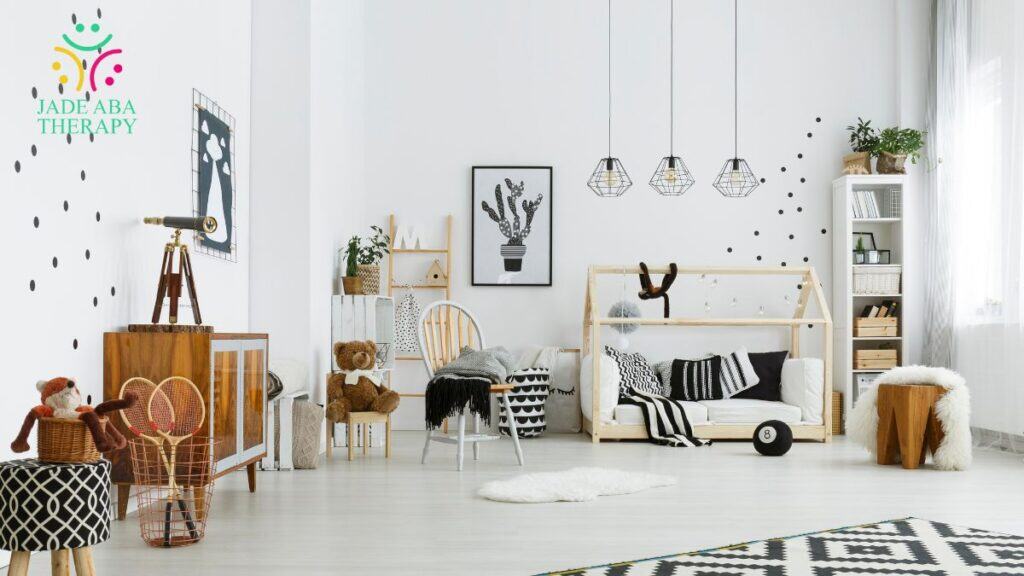Key Points:
- In-home ABA therapy setup improves learning by matching goals to real routines in each room, like play in the living room or hygiene in the bathroom.
- Simple visuals, labeled bins, and caregiver cues reduce delays and boost daily practice.
- A consistent layout makes sessions smoother and skills stick better.
Mornings feel rushed, afternoons feel scattered, and sessions keep moving from one spot to another. In-home ABA setup gives structure to the day without turning the house into a clinic. The plan uses small changes to room layout, storage, and cues so practice happens during real routines. Expect clear steps and a few evidence points woven in for context.
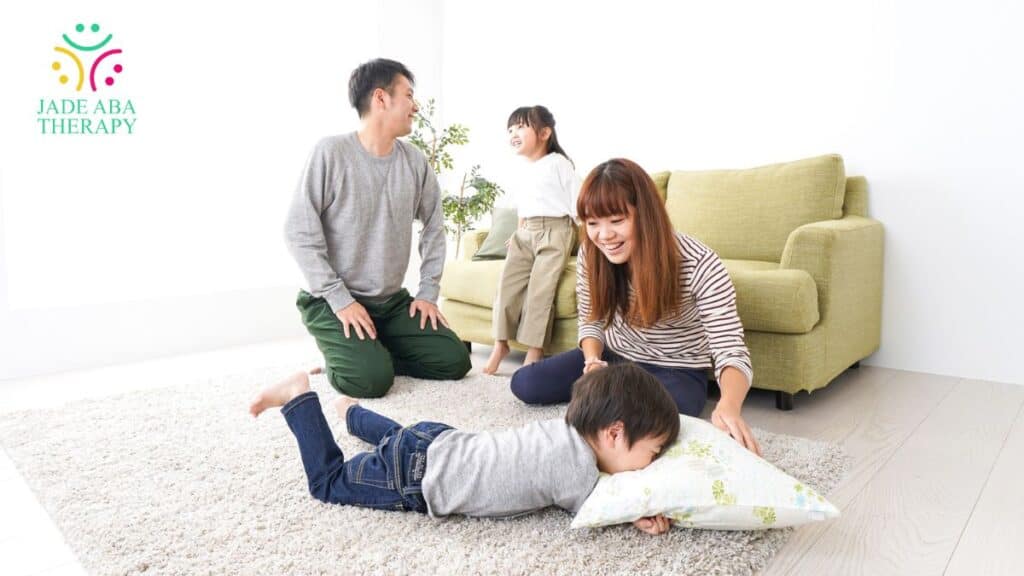
What Does an In-Home ABA Setup Need?
A strong in-home ABA setup groups activities by room, keeps visuals simple, and puts tools where the action happens. Start with three goals: increase practice chances, reduce wait time between tasks, and make it easy for any caregiver to run the plan.
Use one primary target per area. Living room for joint play. Kitchen for requesting and mealtime routines. Bathroom for hygiene steps. Bedroom for sleep and wind-down habits. Entryway for transitions and leaving the house.
Set basic rules across rooms:
- Clear surfaces limit distraction.
- Labeled bins speed cleanup and reset.
- Visuals stay at the child’s eye level.
Parents can run many steps between sessions using ideas from parent education and autism. Simple coaching turns common moments into teaching. A recent national estimate shows how many families seek support now, with the CDC reporting about 1 in 31 8-year-olds identified with autism; planning the home well helps families use each day better.
Try it now: Pick one routine, place the needed items in a bin, post a 3-step visual, and rehearse the steps once per day.
Living Room Setup: Play, Turns, and Communication
The living room often becomes the shared play space. Plan for joint attention, imitation, and early conversation supported by autism social skills training. Keep a short list of toys that support matching, sorting, building, and pretend. Rotate weekly to keep novelty without clutter.
Create mini zones:
- Floor play mat for blocks, cars, and pretend scenes.
- Small table for puzzles and fine-motor tasks.
- Reading corner for joint book time and labeling.
Run quick teaching loops. Model, prompt, and praise. Use 3–5 trials, then shift. Keep targets visible on a small card for the adult. Add one caregiver-friendly cue each week. This section works well for ABA therapy techniques for parents who want quick, repeatable wins.
Checklist for the room:
- Post one visual for “My turn, your turn, clean up.”
- Store 3–5 core toys in clear bins.
- Keep a simple timer to teach waiting.

Kitchen & Meals: Requests, Waiting, and Independence
The kitchen offers frequent chances to request items, follow directions, and learn safety. Place cups, utensils, and preferred snacks where a child can point, sign, or use words or AAC. Use short, concrete language.
Build mealtime routines:
- Before: wash hands, set mat, choose cup.
- During: request items, try one bite, sip water.
- After: wipe table, put dishes in sink, wash hands.
Teach waiting with small steps. Start with 5–10 seconds and build. Use a “First–Then” card to link work to a natural reward, like fruit or yogurt. For families seeking ABA strategies for parents, the kitchen becomes a daily practice zone without extra worksheets.
Safety tip: Hot surfaces, sharp tools, and cleaning products out of reach. A national pediatric center notes more than 3.4 million children have an unintentional home injury each year, so simple safeguards matter in this room.
Bathroom Routines: Hygiene, Toileting, and Step Independence
The bathroom supports hygiene chains with clear steps: enter, pants down, sit, wipe, flush, pants up, wash, dry, and exit. Place visuals near the toilet and sink. Keep wipes, extra clothes, and a wet bag in a labeled bin to reduce delays when accidents happen.
Use chaining to teach long routines drawn from ABA therapy for autism principles:
- Forward chaining starts at step one and builds.
- Backward chaining teaches the last step first for quick success.
- Total task walks the whole chain with prompts, then fades.
Add short reinforcement right after success. If toothbrushing is tough, break it down: open toothpaste, place pea-sized amount, brush top teeth, brush bottom teeth, spit, and rinse.
Toileting tips:
- Put a small footstool for posture and balance.
- Use a seat reducer for security.
- Track 3–5 days of patterns to time sits well.
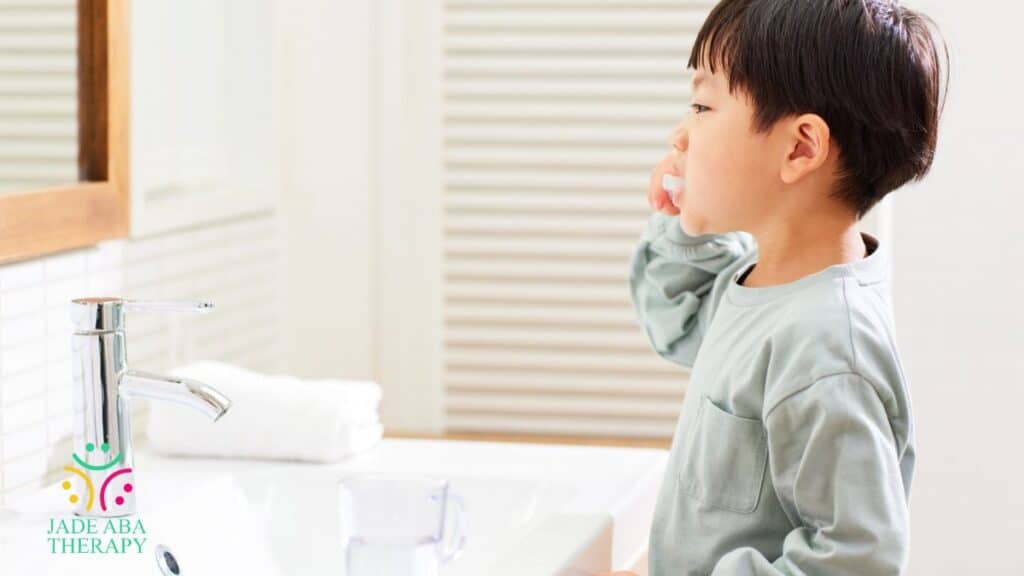
Bedroom Setup: Better Sleep, Calmer Evenings
The bedroom anchors the wind-down of the day. Keep the space quiet, cool, and dark. Use one basket for bedtime books and one for fidgets used only before lights out. Avoid piles of toys that compete for attention.
Build a predictable sequence:
- One calming activity, such as gentle stretching, simple puzzles, or quiet reading.
- Short visual schedule for pajamas, brush teeth, story, lights.
- Consistent sleep cues like white noise and blackout curtains.
If falling asleep runs long, adjust timing in 10–15 minute increments each week. Avoid late naps. For autism therapy resources, choose one set of sleep visuals and reuse across caregivers so the plan stays consistent.
When early waking happens:
- Delay morning light and noise.
- Keep the first activity calm.
- Offer water or bathroom, then quiet play in bed.
Entryway & Transitions: Out-the-Door Skills
The entryway teaches packing, waiting, and leaving without drama. Use a low hook for a backpack and a basket for shoes. Post a mini schedule near the door. Keep a tiny “go kit” with chewable snacks, a favorite small toy, and noise-dampening headphones.
Practice short trips:
- Stand at the door, put on shoes, open, step outside, close, return.
- Add car steps later: walk to car, open, climb in, buckle.
- Use short praise and one small reward after each successful run.
For families learning in-home ABA therapy routines, the entryway becomes a daily practice lane that pays off at school drop-off and errands.
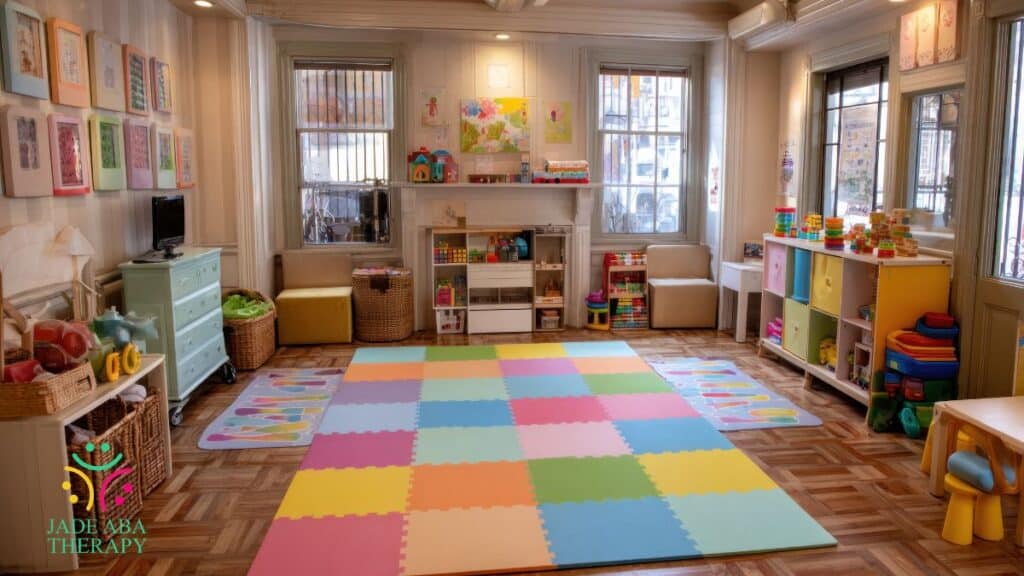
Materials & Storage: Keep It Simple, Reset Fast
Clutter slows momentum. Keep one bin per skill set and label it with a photo. Rotate items weekly. Store everything the child uses at their level. Store adult materials higher.
Start with a small kit:
- Play kit: blocks, cars, people figures, two pretend items.
- Table kit: puzzles, matching cards, crayons, safety scissors.
- Token kit: token board, small stickers, tiny prizes.
Set a 5-minute end-of-day reset. Children can match items to photos and place bins on marked shelves. For teams working as a behavior technician at home, this system aligns with the basics covered in the ABA therapy FAQ and keeps sessions on track even when staff rotate.
Tech, Data, and Coaching: Light-Touch Tools That Help
Simple tech supports consistency. Use a phone timer, a notes app for data tallies, and a shared cloud note for targets. Record 5–10 data points per activity instead of every trial. Share one highlight and one challenge with the BCBA each day.
Telehealth ABA can extend coaching on weeks with tight schedules. Several trials show that ABA parent training delivered remotely helps caregivers use strategies accurately and improves child communication for many families. Keep sessions brief and focused on one routine so the plan fits into daily life.
If you want more autism ABA resources or ABA therapy resources, pick one source for visuals and training videos and avoid hopping between styles. A short library used well beats a full bookmark folder no one opens.
Safety First: Layout, Hazards, and Calm Plans
Home safety blends environment with teaching. Lock cleaners and medicines. Use stove knob covers and cord clips. Anchor large furniture. Place outlet covers where needed. Teach stop, wait, and hand-to-adult as part of movement routines.
Create a calm plan for rising stress:
- Visual cue for break.
- Safe space such as a tent or beanbag corner.
- Short script adults follow to reduce noise and demands.
Reinforce recovery moments and teach simple requests like “break,” “help,” or “more later.” Basic safety reduces injuries and missed practice time. When planning rooms, remember many programs run intensive schedules; “intensive” often means 25 to 40 hours per week over one to three years, depending on needs.
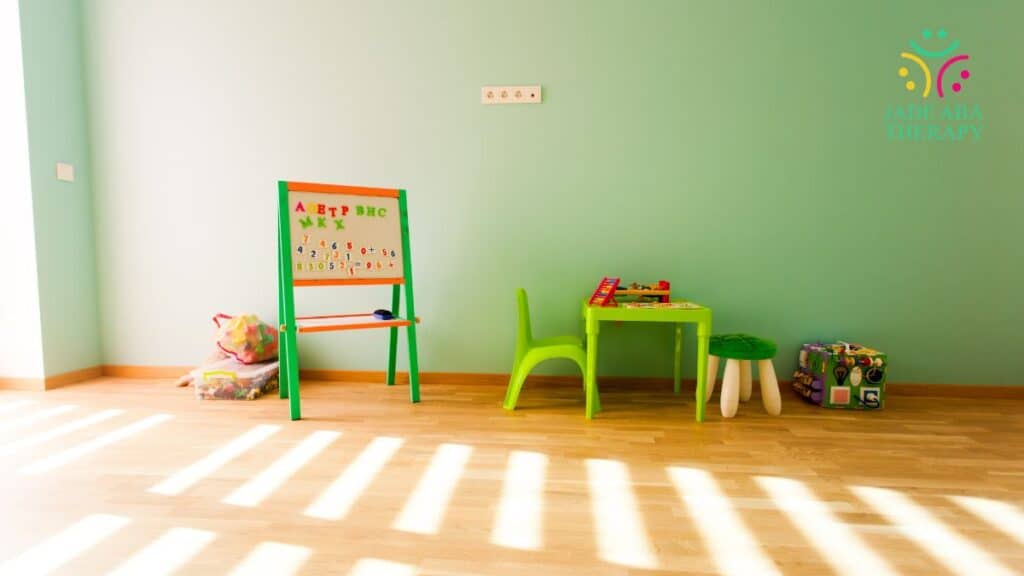
Frequently Asked Questions
How much does ABA cost in-home?
In-home ABA therapy costs depend on the state, insurer, and service type. Families typically pay based on hourly rates for BCBA supervision and RBT direct care, adjusted by insurance coverage. Request a benefits check and treatment plan to estimate monthly costs before starting.
Does insurance cover in-home ABA?
Insurance often covers in-home ABA therapy when prescribed by a qualified clinician and deemed medically necessary. Coverage typically includes direct care, supervision, and parent training, but prior authorization is usually required. Confirm benefits by requesting a written summary of covered ABA CPT codes and related requirements.
Is in-home ABA therapy worth it?
In-home ABA therapy is often worth it when goals, schedule, and priorities align. Families benefit from skill practice in daily routines, reduced travel, and stronger parent involvement. Steady progress on targeted behaviors makes the investment worthwhile for many caregivers.
Get a Home Plan That Works Day-to-Day
A clear in-home ABA setup turns rooms into learning spaces and keeps practice short, frequent, and meaningful. Our team provides in-home ABA therapy in Virginia and Maryland, pairing measurable goals with routines you already do.
At Jade ABA Therapy, a BCBA designs the plan, trains caregivers, and updates targets based on weekly data. Families see what each session will look like, what to practice between visits, and how progress will be tracked.
If you want a plan that fits your home and builds skills you can use every day, reach out to start a conversation about a tailored program for your child.
